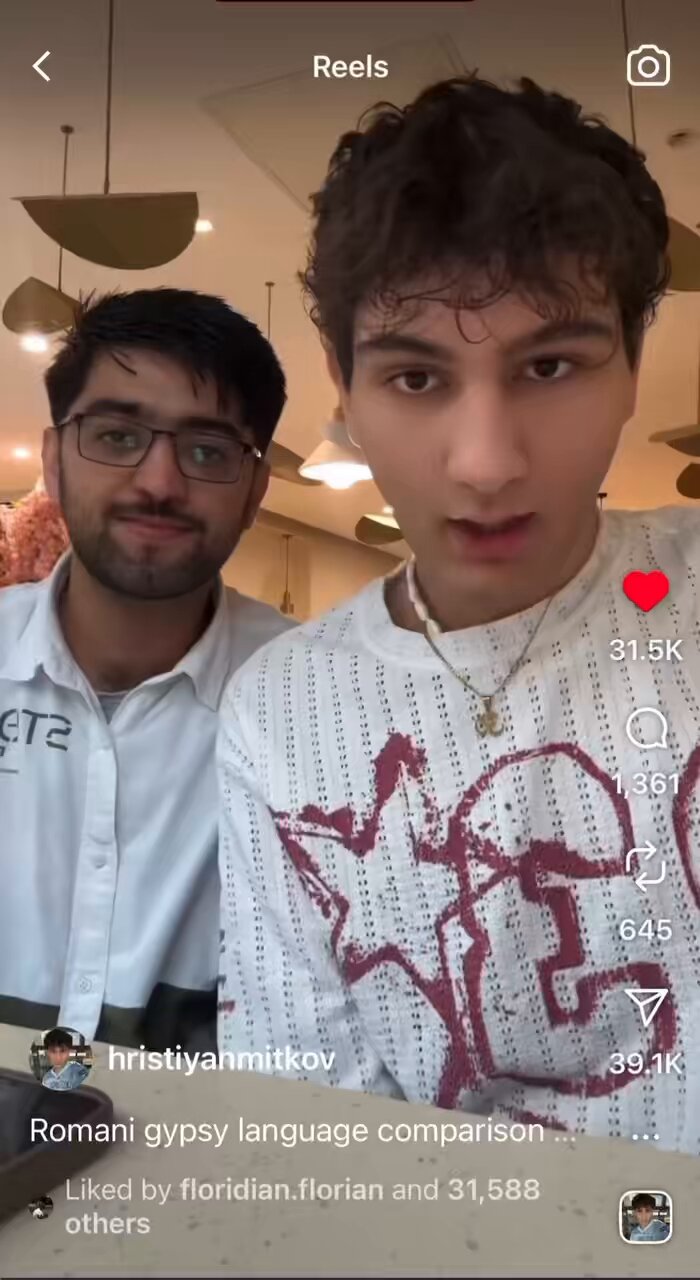Hindi and Urdu Influence Seen in Romani Language
The internet is buzzing after a viral video revealed how closely the Romani Gypsy language resembles Hindi and Urdu. Shared by Bulgarian Instagram user Hristiyan, the video captured global attention as he compared everyday words from his Romani dialect with similar ones in Hindi, Urdu, and Punjabi.
Hristiyan, who hails from one of Bulgaria’s oldest Roma tribes, explained that his ancestors migrated from India nearly 1,500 years ago. Despite this long separation, their language has retained several familiar words and structures, leaving millions amazed at how little has changed over the centuries. “My ancestors left India, but our language never forgot its roots,” he said in the video, which quickly went viral across multiple platforms.

The video shows multiple examples that highlight these linguistic ties. For instance, “kaangli” in Romani means “comb,” much like “kanghi” in Hindi and Urdu. Similarly, “bakro” in Romani translates to “goat,” identical to “bakra” used in Hindi and Urdu. Even more surprisingly, the word for snake remains “saanp,” and fish is called “machcho,” both directly resembling their Indian counterparts.
Shared History Between Romani, Hindi and Urdu
The Romani people, also known as Roma or Romanies, are an Indo-Aryan ethnic group with historical roots in the Indian subcontinent. Linguistic and genetic research has consistently traced their origins to regions that are now part of Punjab, Rajasthan, and Sindh areas where both Hindi and Urdu have deep cultural and linguistic influence.
Over several centuries, the Roma migrated westward through Persia and into Europe, eventually settling in regions like Romania, Bulgaria, Hungary, and Slovakia. Although they adapted to European cultures, their native tongue, Romani, preserved countless elements of its Indian origin.
Scholars note that the structure, phonetics, and vocabulary of Romani share an unmistakable resemblance to Hindi and Urdu, confirming their shared Indo-Aryan lineage. The most fascinating part is how this linguistic connection survived 15 centuries and vast geographical distances, showing the endurance of cultural memory through language.
Internet Reactions to the Viral Discovery
The viral video comparing Hindi and Urdu with Romani sparked widespread curiosity and admiration online. Thousands of viewers expressed astonishment at how languages separated by continents could sound so alike.
“I knew the Roma came from India, but I never expected the languages to be this similar,” commented one user. Another wrote, “This is like hearing echoes of ancient India in Europe.” A Bulgarian woman shared a touching memory: “When my father was young in the 1960s, Roma children would sneak into theatres to watch Bollywood films and said they understood everything they thought the actors were speaking Romani!” Also Read: Maitreyi Ramakrishnan Shines in 2025: Living Her Best Timeline with Purpose and Positivity
Such stories have reignited interest in the Roma community’s deep-rooted Indian connection, bridging cultural gaps and reminding the world of shared linguistic heritage. The comment sections across platforms are now filled with people sharing examples of similar words, turning the post into an interactive celebration of history and language.
A Journey of Language and Identity
What makes this revelation about Hindi and Urdu and Romani so compelling is not just the similarity of words but the story they carry. For centuries, the Roma people were known primarily for their nomadic traditions and vibrant culture spread across Europe. Yet, behind their music, folklore, and colorful attire lies a powerful linguistic bridge to South Asia.
Many linguists believe that the preservation of Indo-Aryan words in Romani showcases the strength of oral tradition and community memory. While Roma populations adopted new influences from Persian, Greek, and Slavic languages, the foundation of their speech still carries Indian traces a testament to how language travels through generations.
View this post on Instagram
Conclusion
The viral video has sparked more than curiosity it has reignited a sense of shared heritage between the Romani people and speakers of Hindi and Urdu. Despite 1,500 years of separation, the connection between these languages remains undeniable. This discovery reminds us that while cultures evolve and borders change, language holds the power to preserve identity, memory, and history across time.

